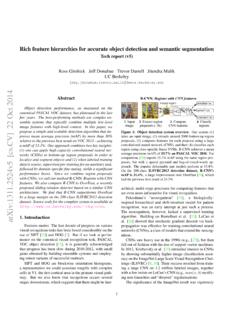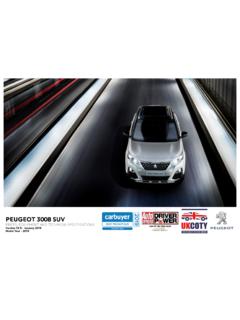Transcription of Selective Search for Object Recognition - Koen van de Sande
1 Selective Search for Object Uijlings 1,2, van de Sande 2, T. Gevers2, and Smeulders21 University of Trento, Italy2 University of Amsterdam, the NetherlandsTechnical Report 2012, submitted to IJCVA bstractThis paper addresses the problem of generating possible Object lo-cations for use in Object Recognition . We introduce Selective Searchwhich combines the strength of both an exhaustive Search andseg-mentation. Like segmentation, we use the image structure toguideour sampling process. Like exhaustive Search , we aim to captureall possible Object locations. Instead of a single technique to gen-erate possible Object locations, wediversifyour Search and use avariety of complementary image partitionings to deal with as manyimage conditions as possible.
2 Our Selective Search resultsin asmall set of data-driven, class-independent, high qualitylocations,yielding 99% recall and a Mean Average Best Overlap of at10,097 locations. The reduced number of locations comparedtoan exhaustive Search enables the use of stronger machine learningtechniques and stronger appearance models for Object this paper we show that our Selective Search enables the use ofthe powerful Bag-of-Words model for Recognition . The SelectiveSearch software is made publicly IntroductionFor a long time, objects were sought to be delineated before theiridentification. This gave rise to segmentation, which aims fora unique partitioning of the image through a generic algorithm,where there is one part for all Object silhouettes in the image.
3 Re- Search on this topic has yielded tremendous progress over the pastyears [3, 6, 13, 26]. But images are intrinsically hierarchical: InFigure 1a the salad and spoons are inside the salad bowl, which inturn stands on the table. Furthermore, depending on the context thetermtablein this picture can refer to only the wood or include ev-erything on the table. Therefore both the nature of images and thedifferent uses of an Object category are hierarchical. Thisprohibitsthe unique partitioning of objects for all but the most specific pur-poses. Hence for most tasks multiple scales in a segmentation are anecessity. This is most naturally addressed by using a hierarchicalpartitioning, as done for example by Arbelaezet al.
4 [3].Besides that a segmentation should be hierarchical, a generic so-lution for segmentation using a single strategy may not exist at are many conflicting reasons why a region should be groupedtogether: In Figure 1b the cats can be separated using colour, buttheir texture is the same. Conversely, in Figure 1c the chameleon (a)(b)(c)(d)Figure 1: There is a high variety of reasons that an image regionforms an Object . In (b) the cats can be distinguished by colour, nottexture. In (c) the chameleon can be distinguished from the sur-rounding leaves by texture, not colour. In (d) the wheels canbe partof the car because they are enclosed, not because they are similarin texture or colour.
5 Therefore, to find objects in a structured wayit is necessary to use a variety of diverse strategies. Furthermore,an image is intrinsically hierarchical as there is no singlescale forwhich the complete table, salad bowl, and salad spoon can be foundin (a).is similar to its surrounding leaves in terms of colour, yet its tex-ture differs. Finally, in Figure 1d, the wheels are wildly differentfrom the car in terms of both colour and texture, yet are enclosedby the car. Individual visual features therefore cannot resolve theambiguity of , finally, there is a more fundamental problem. Regions withvery different characteristics, such as a face over a sweater, canonly be combined into one Object after it has been established thatthe Object at hand is a human.
6 Hence without prior Recognition it ishard to decide that a face and a sweater are part of one Object [29].This has led to the opposite of the traditional approach: to dolocalisation through the identification of an Object . This recent ap-proach in Object Recognition has made enormous progress in lessthan a decade [8, 12, 16, 35]. With an appearance model learnedfrom examples, an exhaustive Search is performed where every lo-cation within the image is examined as to not miss any potentialobject location [8, 12, 16, 35].1 However, the exhaustive Search itself has several every possible location is computationally Search space has to be reduced by using a regular grid, fixedscales, and fixed aspect ratios.
7 In most cases the number of lo-cations to visit remains huge, so much that alternative restrictionsneed to be imposed. The classifier is simplified and the appearancemodel needs to be fast. Furthermore, a uniform sampling yieldsmany boxes for which it is immediately clear that they are notsup-portive of an Object . Rather then sampling locations blindly usingan exhaustive Search , a key question is: Can we steer the samplingby a data-driven analysis?In this paper, we aim to combine the best of the intuitions of seg-mentation and exhaustive Search and propose a data-drivenselec-tive Search . Inspired by bottom-up segmentation, we aim to exploitthe structure of the image to generate Object locations.
8 Inspired byexhaustive Search , we aim to capture all possible Object , instead of using a single sampling technique, weaimtodiversifythe sampling techniques to account for as many imageconditions as possible. Specifically, we use a data-driven grouping-based strategy where we increase diversity by using a variety ofcomplementary grouping criteria and a variety of complementarycolour spaces with different invariance properties. The set of lo-cations is obtained by combining the locations of these comple-mentary partitionings. Our goal is to generate a class-independent,data-driven, Selective Search strategy that generates a small set ofhigh-quality Object application domain of Selective Search is Object therefore evaluate on the most commonly used dataset for thispurpose, the Pascal VOC detection challenge which consistsof 20object classes.
9 The size of this dataset yields computational con-straints for our Selective Search . Furthermore, the use of this datasetmeans that the quality of locations is mainly evaluated in terms ofbounding boxes. However, our Selective Search applies to regionsas well and is also applicable to concepts such as grass .In this paper we propose Selective Search for Object main research questions are: (1) What are good diversificationstrategies for adapting segmentation as a Selective searchstrategy?(2) How effective is Selective Search in creating a small setof high-quality locations within an image? (3) Can we use Selective searchto employ more powerful classifiers and appearance models for ob-ject Recognition ?
10 2 Related WorkWe confine the related work to the domain of Object recognitionand divide it into three categories: Exhaustive Search , segmenta-tion, and other sampling strategies that do not fall in either Exhaustive SearchAs an Object can be located at any position and scale in the image,it is natural to Search everywhere [8, 16, 36]. However, the visualsearch space is huge, making an exhaustive Search computationallyexpensive. This imposes constraints on the evaluation costper lo-cation and/or the number of locations considered. Hence most ofthese sliding window techniques use a coarse Search grid andfixedaspect ratios, using weak classifiers and economic image featuressuch as HOG [8, 16, 36].







